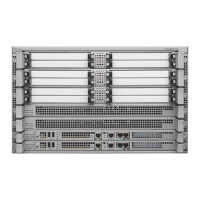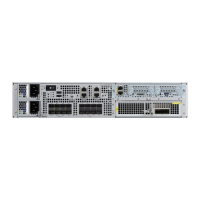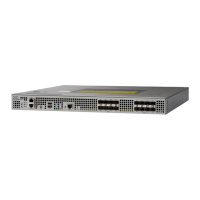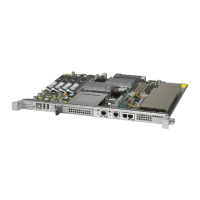19-21
Cisco ASR 1000 Series Aggregation Services Routers SIP and SPA Software Configuration Guide
OL-14127-08
Chapter 19 Configuring the 1-Port Channelized OC-3/STM-1 SPA and 1-Port Channelized OC-12/STM-4 SPA
Configuration Tasks
Configuring LFI
Link Fragmentation and Interleaving (LFI) is implemented on the QFP on the Cisco ASR 1000 Series
Routers. QFP-based LFI supports LFI on a bundle with any number of links—from one link, up to the
maximum number supported by the router. When using LFI on MLPPP, the QFP load balances the
priority packets across all links in the bundle to minimize the latency on the priority interleaved traffic.
LFI Configuration Guidelines
When you configure LFI, consider the following guidelines:
• Configure LFI using the ppp multilink interleave command. For MLPPP, this is on the multilink
interface.
• Configure and apply an output QoS service-policy that classifies the priority and non-priority traffic.
For MLPPP, you can apply the output policy on the multilink interface.
LFI Restrictions
When you configure LFI, note the following restrictions:
• Virtual-template interfaces are not supported.
• Packet ordering is not guaranteed for priority traffic sent interleaved on an MLPPP bundle with
multiple links.
• IP header compression (such as, cRTP, cUDP, or cTCP) is not supported on packets classified by
QoS as priority packets when using LFI on an MLPPP bundle with multiple links. IP header
compression requires packet ordering. LFI sends all priority packets using PPP encapsulation,
which does not preserve packet order when there are multiple links in the bundle. If you must
support IP header compression, then you should not configure LFI or you should not make the LFI
traffic priority. MLP encapsulation on non-priority QoS classes does preserve packet ordering.
To configure LFI on a multilink interface, use the following commands:
Inverting Data on the T1/E1 Interface
If the interface on the channelized SPA is used to drive a dedicated T1 line that does not have B8ZS
encoding, you must invert the data stream on the connecting CSU/DSU or on the interface. Be careful
not to invert data on both the CSU/DSU and the interface, as two data inversions will cancel each other
out. To invert data on a T1/E1 interface, use the following commands:
Command Purpose
Step 1
Router# configure terminal Enters global configuration mode.
Step 2
Router(config)# interface
multilink group-number
Creates or specifies a multilink interface and enters multilink
interface mode, where:
• group-number—The group number for the multilink bundle.
Range 1-2147483647
Step 3
Router(config-if) ppp multilink Enables Multilink PPP.
Step 4
Router(config-if)# ppp multilink
interleave
Enables interleaving of packets among the fragments of larger
packets on an MLP bundle.

